

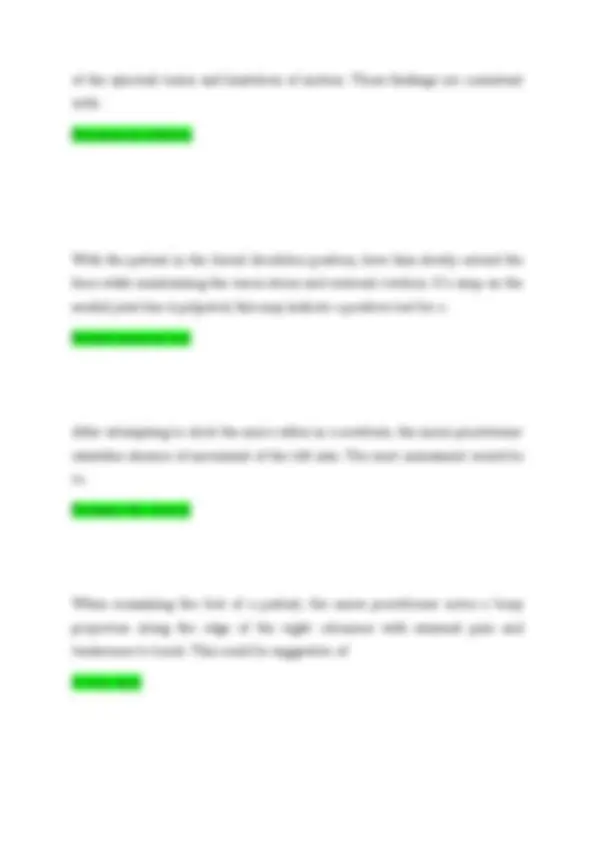
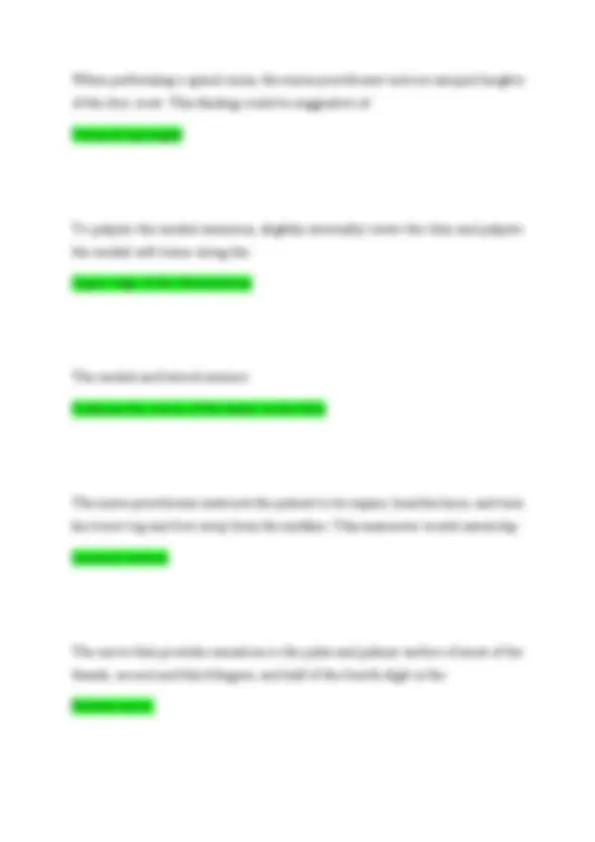
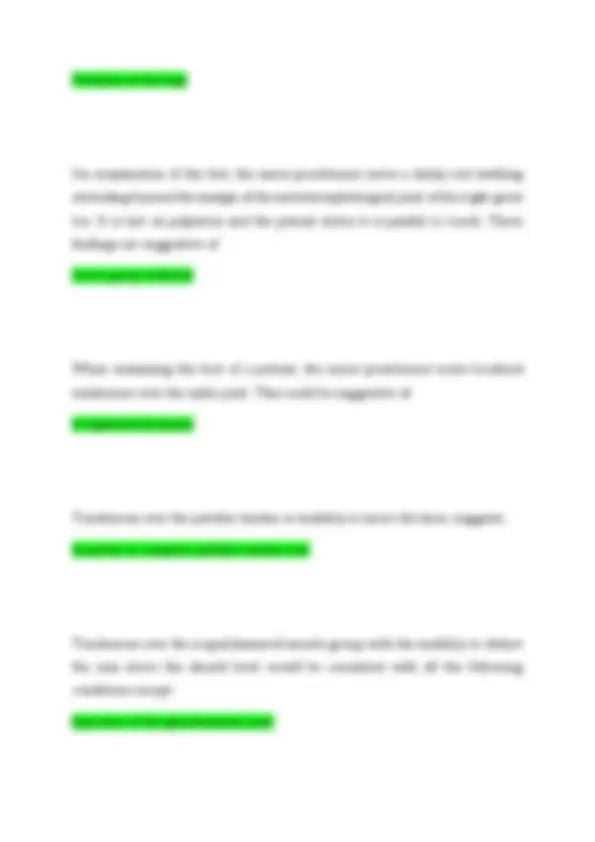


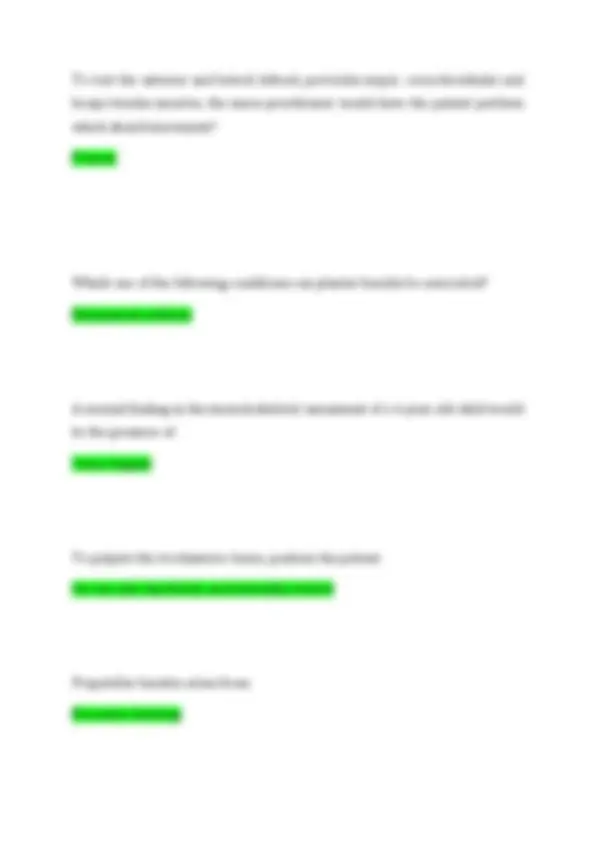
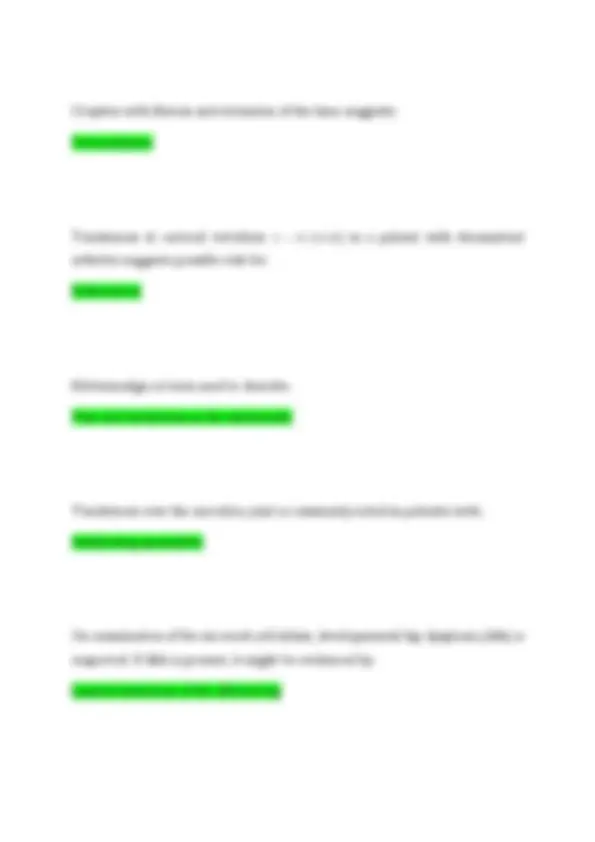
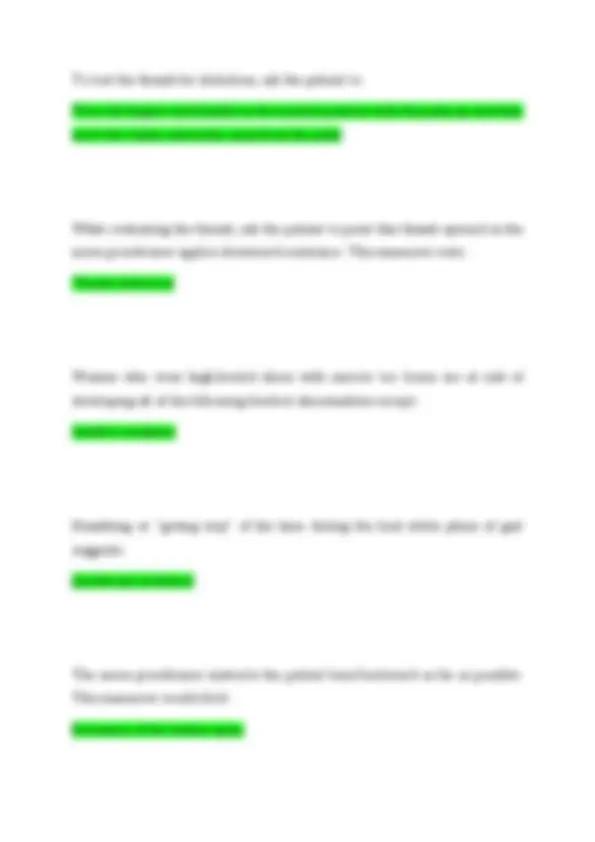
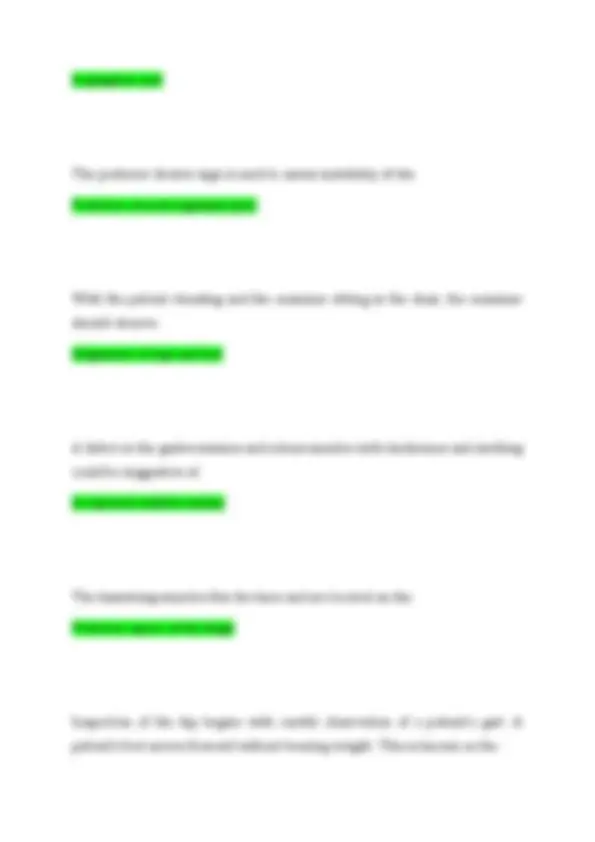
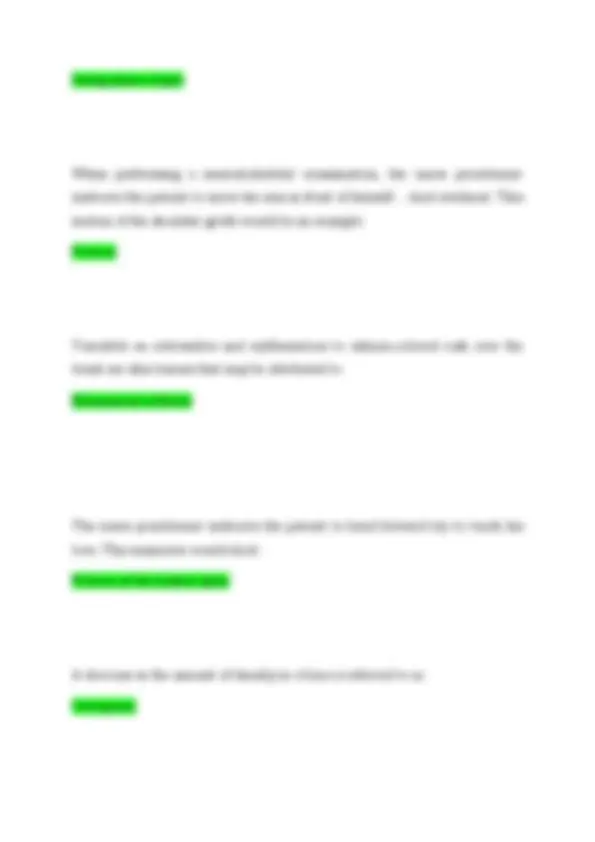
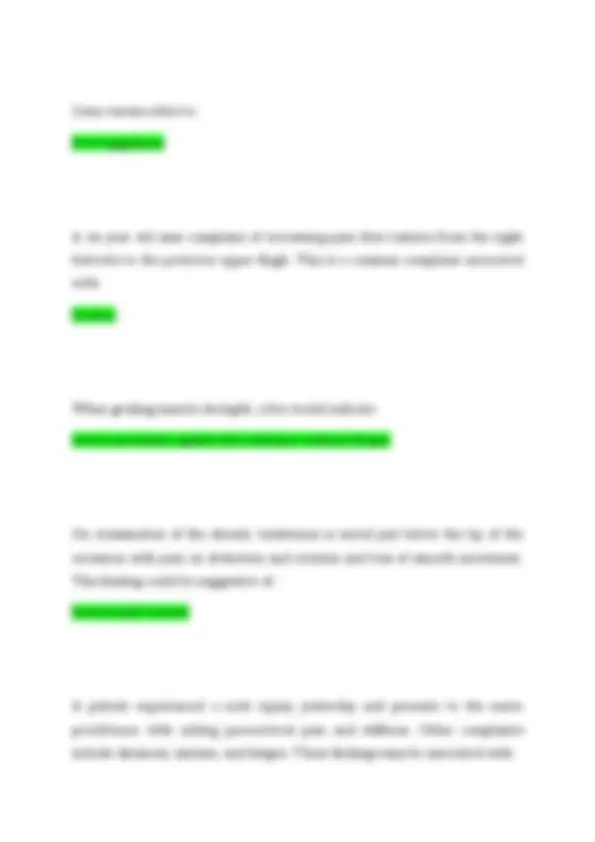

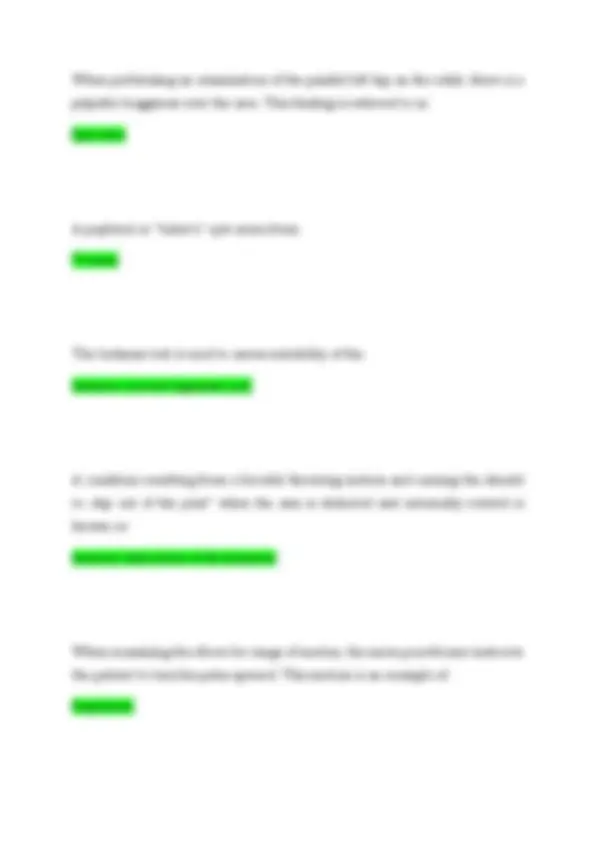

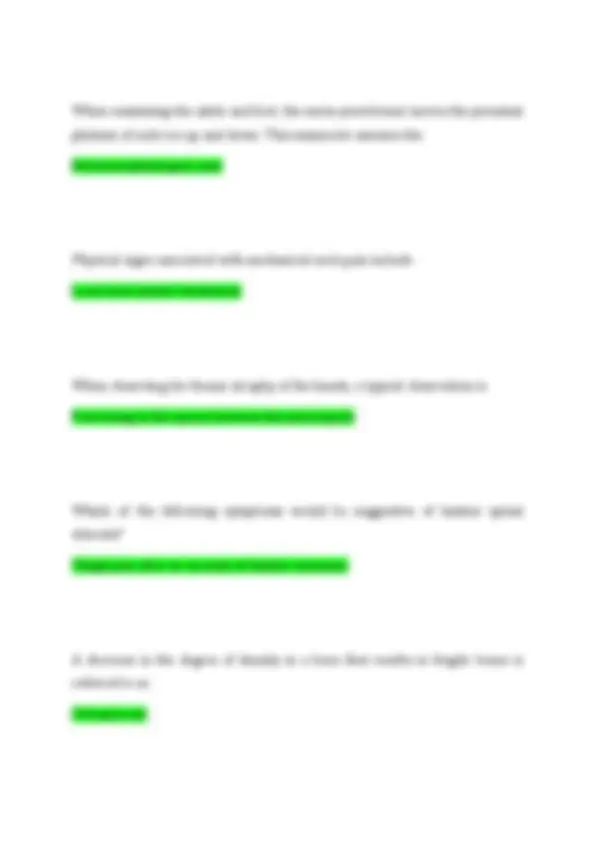



Study with the several resources on Docsity

Earn points by helping other students or get them with a premium plan


Prepare for your exams
Study with the several resources on Docsity

Earn points to download
Earn points by helping other students or get them with a premium plan
Community
Ask the community for help and clear up your study doubts
Discover the best universities in your country according to Docsity users
Free resources
Download our free guides on studying techniques, anxiety management strategies, and thesis advice from Docsity tutors
NSG 6020 - ORTHOPEDICS | QUESTIONS AND ANSWERS | 2025-2026 | GRADED A+
Typology: Exams
1 / 25

This page cannot be seen from the preview
Don't miss anything!


















When examining the foot of a patient, the nurse practitioner notes tenderness of the posterior medial malleolus. This could be suggestive of: Tibial tendinitis When testing hand grip strength on a patient, the nurse practitioner asks the patient to squeeze which finger(s)?: Second and third fingers A thickened nodule overlying the flexor tendon of the 4th finger and possibly the 5th finger near the distal palmar crease is suggestive of: Dupuytren's contracture The forward slippage of one vertebrae resulting in spinal cord compression is referred to as: Spondylolisthesis
Apatient complains of shooting pains below the knee radiating into the lateral leg and calf. This type of low back pain is referred to as: Radicular low back pain Thenar atrophy suggests: A median nerve disorder What test is performed when the nurse practitioner instructs the patient to hold his wrists in flexion for 60 seconds while pressing back on his hands together to form right angles: Phalen's test When inspecting the should and shoulder girdle, the rounded lateral aspect of the should appears flattened. This finding could be associated with: Anterior should dislocation When inspecting the shoulder and shoulder girdle, an elevation of the right should was noted this finding could be associated with: Scoliosis
of the synovial tissue and limitation of motion. These findings are consistent with: Rheumatoid arthritis With the patient in the dorsal decubitus position, have him slowly extend the knee while maintaining the varus stress and external rotation. If a snap on the medial joint line is palpated, this may indicate a positive test for a : Medial meniscal tear After attempting to elicit the moro reflex in a newborn, the nurse practitioner identifies absence of movement of the left arm. The next assessment would be to: Examine the clavical When examining the foot of a patient, the nurse practitioner notes a bony projection along the edge of the right calcaneus with minimal pain and tenderness to touch. This could be suggestive of: A bone spur
When performing a spinal exam, the nurse practitioner notices unequal heights of the iliac crest. This finding could be suggestive of: Unequal leg length To palpate the medial meniscus, slightly internally rotate the tibia and palpate the medial soft tissue along the: Upper edge of the tibial plateau The medial and lateral menisci: Cushions the action of the femur on the tibia The nurse practitioner instructs the patient to lie supine, bend his knee, and turn his lower leg and foot away from the midline. This maneuver would assess hip: Internal rotation The nerve that provides sensation to the palm and palmar surface of most of the thumb, second and third fingers, and half of the fourth digit is the: Median nerve.
Which one of the following ligaments of the foot is most at risk of injury from inversion? Anterior talofibular ligament Contracture of the sternocleidomastoid muscle could result in lateral deviation and rotation of the head. This condition is suggestive of: Torticollis A six year old male complains of ankle pain and difficulty walking ,but denies any recent injuries. Findings reveal ankle tenderness, decreased mobility and range of motion. The patients temperature of 102 degrees. These fingins are consistent with Osteomyelitis A dislocation of the elbow joint caused by the sudden pull on the extended pronation forearm is referred to as: Nursemaid's elbow When describing muscle strength, the term paraplegia means:
Paralysis of the legs On examination of the feet, the nurse practitioner notes a dusky red swelling extending beyond the margin of the metatarsophalangeal joint of the right great toe. It is hot on palpation and the patient states it is painful to touch. These findings are suggestive of Acute gouty arthritis When examining the foot of a patient, the nurse practitioner notes localized tenderness over the ankle joint. This could be suggestive of: A ligamentous injury Tenderness over the patellar tendon or inability to move the knee, suggests: A partial or complete patellar tendon tear Tenderness over the scapulohumeral muscle group with the inability to abduct the arm above the should level would be consistent with all the following conditions except: Synovitis of the glenohumeral joint
When a patient complains of joint pain as progressing from one joint to another, the examiner should consider this pattern of involvement as migratory. This type of involvement would most likely be observed in a patient who has: Rheumatic fever Passive flexion, varus stress, and external rotation of the lower leg evaluates the: Lateral menisucs The area located between the olecranon process and the skin is known as the: Olecranon bursa Flexion contracture of the knee suggests hamstring tightness or: Limb paralysis Olecranon bursitis may be caused by all the following except:
Frozen shoulder The gastrocnemius and soleus muscles are located by palpating the: Posterior surface of the lower leg When examining the medial and lateral meniscus, a click along the medial joint with valgus stress, external rotation, and leg extension suggest a probable tear of the: Posterior portion of the medial meniscus The nerve that provides sensation to the dorsal web of the thumb and index finger is the: Radial nerve Which nerve in the arm is located in the ventral forearm and is just medial to the brachial artery in the antecubital fossa? Median nerve
To test the anterior and lateral deltoid, pectoralis major, coracobrachialis and biceps brachii muscles, the nurse practitioner would have the patient perform which should movement? Flexion Which one of the following conditions can plantar fasciitis be associated? Rheumatoid arthritis A normal finding in the musculoskeletal assessment of a 3-year-old child would be the presence of: Genu-valgum To palpate the trochanteric bursa, position the patient: On one side, hip flexed, and internally rotated Prepatellar bursitis arises from: Excessive kneeling
Crepitus with flexion and extension of the knee suggests: Osteoarthritis Tenderness at cervical vertebrae 1 - 2 (c1-2) in a patient with rheumatoid arthritis suggests possible risk for: Subluxation Metatarsalgia is term used to describe: Pain and tenderness in the metatarsals Tenderness over the sacroiliac joint is commonly noted in patients with: Ankylosing sponsylitis On examination of the six-week-old infant, developmental hip dysplasia (ddh) is suspected. If dhh is present, it might be evidenced by: Limited abduction of the affected leg
A small, tuberculated eminence, curved a little forward, and giving attachment to the radial collateral ligament of the elbow joint referred to as the: Lateral epicondyle of the humerus A patient complains of a sharp burning pain in the neck and right arm with associated parenthesias and weakness. These symptoms may be associated with: Cervical radiculopathy When assessing the knee, the examiner instructs the patient to sit and swing his lower leg away from midline. This motion would assess knee: External rotation The nurse practitioner instructs the patient to move his extended fingers so that each touches its nearest finger. This motion assesses the fingers and thumbs for: Adduction When performing an examination of painful left wrist in an adult, there is a palpable crunching sound during flexion. This finding is referred to as: Crepitus
When grading muscle strength, a grade of two would indicate: Active movement of the body part with gravity eliminated When examining the knee, which of the following symptoms could be indicative of a positive adduction (varus) stress test? Pain in the lateral joint line When screening for scoliosis, assessment should include: Observing the back while the child is bending forward When examining the elbow, swelling over the olecranon process is noted. This finding could be suggestive of: Bursitis On examination of the left wrist, the nurse practitioner notes a slightly tender .75 cm swelling along the joint capsule during flexion of the wrist. This finding could be suggestive of:
Swing phase of gait When performing a musculoskeletal examiniation, the nurse practitioner instructs the patient to move his arm in front of himself.... And overhead. This motion of the shoulder girdle would be an example: Flexion Vasculitis on extremities and erythematous to salmon-colored rash over the trunk are skin lesions that may be attributed to: Rheumatoid arthritis The nurse practitioner instructs the patient to bend forward try to touch his toes. This maneuver would elicit: Flexion of the lumbar spine A decrease in the amount of density in a bone is referred to as: Osteopenia
Genu varum refers to: Bow leggedness A 64 year old man complains of worsening pain that radiates from the right buttocks to the posterior upper thigh. This is a common complaint associated with: Sciatica When grading muscle strength, a five would indicate: Active movement against full resistance without fatigue On examination of the should, tenderness is noted just below the tip of the acromion with pain on abduction and rotation and loss of smooth movement. This finding could be suggestive of: Subacromial bursitis A patient experienced a neck injury yesterday and presents to the nurse practitioner with aching paracervical pain and stiffness. Other complaints include dizziness, malaise, and fatigue. These findings may be associated with: